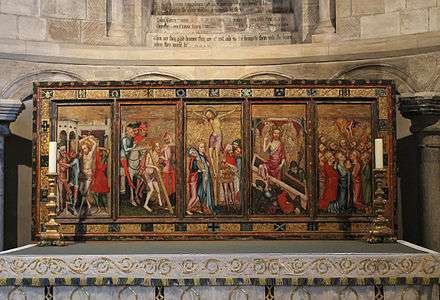Despenser reredos
The Despenser reredos consists of five panels of art illustrating biblical scenes from the end of Christ's life. They were commissioned by the Bishop of Norwich, Henry Despenser, in 1382 following his destruction of a rebel peasant army at the Battle of North Walsham the previous year. Historians generally consider him to have been using the opportunity to remind the peasantry of their social position following the Peasants' revolt.

Background
Bishop Despenser
Henry Despenser (c. 1341–1406) was an English nobleman and Bishop of Norwich. Destined for a career in the church from a young age, he spent much of his earlier life at the Papal curia in the service of Pope Urban V. There he fought in the papal armies against the city state of Milan during the crusade against the Visconti.[1][2][3][note 1] The year after the Peasants' Revolt, Despenser had led an army against supprters of the antipope, Clement VII, in Ghent.[5][note 2]
He gained the moniker 'Fighting Bishop' following his suppression of the Peasants' Revolt in East Anglia with his crushing defeat of the rebels at the Battle of North Walsham in June 1381.[1][note 3]
Despenser reredos
Despenser commissioned the new reredos for St Luke's chapel[10] in Norwich Cathedral's priory shortly after putting down the revolt in Norfolk. It comprised five sections, each devoted to a distinct aspect of Christ's final days: his flagellation, the procession to the cross wearing the crown of thorns, and finally his cruxifiction, burial and resurrection.[11][note 4] The medievalist Sarah Beckwith has argued that the commission was directly related to the insurrection in the manner of an object lesson, suggesting that "the peasants who had dared, albeit abortively, to contest their ordained position in the social hierarchy and whose revolutionary gestures were based on an identification with Christ, are once again shown a story, a story they already know very well.[11]
In Despenser's reredos, Christ is shown as humbly accepting his fate from those with the power to prescribe it; a similar position, says Beckwith, to the position the peasantry now found themselves in following their abortive rebellion.[11]
Notes
- The ambitions of the Visconti of Milan, led by Archbishop Giovanni Visconti, resulted in his conquering much of Lombardy. He also seized the Papal city of Bologna and transgressed Florentine territory.[4]
- Although the historian Christopher Tyeman has described Despenser's caaign as "a fiasco" and "a military disaster".[6]
- Despenser may have treated the rebels brutally: a Victorian pamphlet on the history of the church argues that many of those who escaped took sanctuary in the church, but that Despenser "followed the rebels, and slew all who were captured, showing no respect for the sanctuary to which they had retreated".[7]
- The fifth panel—Christ's Resurrection—uses the Anglo-Saxon technique of a "disappearing Jesus", as the scholar Estella Antoaneta Ciobanu puts it, as it shows "the very moment he vanishes into heaven, his upper body hidden in clouds, leaving only his feet or legs visible".[10]
References
- Davies 2004.
- Sumption 2009, p. 111.
- Sismondi 2008, p. 128.
- Theiner 1862, pp. 223–233.
- Tyeman 1996, pp. 335–338.
- Tyeman 1996, p. 337.
- Page 1968, p. 6.
- Guthrie 2013, p. 128.
- Micklethwaite 1874, pp. 98–99.
- Ciobanu 2012, p. 267 n.237.
- Beckwith 1993, p. 22.
Bibliography
- Beckwith, S. (1993). Christ's Body: Identity, Culture and Society in Late Medieval Writings. London: Routledge. ISBN 978-1-13476-157-9.CS1 maint: ref=harv (link)
- Ciobanu, E. A. (2012). The Spectacle of the Body in Late Medieval England. Iași: Editura Lumen. ISBN 978-9-73166-315-9.CS1 maint: ref=harv (link)
- Davies, R. G. (2004). "Despenser, Henry (d. 1406)". Oxford Dictionary of National Biography. Oxford: Oxford University Press. Archived from the original on 2 November 2019. Retrieved 2 November 2019.CS1 maint: ref=harv (link)
- Guthrie, T. H. (2013). Recognizing Heritage: The Politics of Multiculturalism in New Mexico. Lincoln, NE: University of Nebraska Press. ISBN 978-0-80324-610-2.CS1 maint: ref=harv (link)
- Micklethwaite, J. T. (1874). Modern Parish Churches: Their Plan, Design, and Furniture. London: H. S. King. OCLC 945638114.CS1 maint: ref=harv (link)
- Page, C. H. W. (1968). The Story of St. Nicholas' Church, North Walsham, Norfolk (rev. ed.). Norwich. OCLC 977805045.CS1 maint: ref=harv (link)
- Sismondi, J. C. L. de (2008). A History of the Italian Republics (repr. ed.). Gloucester, MA: Wildside Press. ISBN 978-1-43446-064-6.CS1 maint: ref=harv (link)
- Sumption, J. (2009). The Hundred Years' War: Divided Houses. III (paperback ed.). London: Faber & Faber. ISBN 978-0571240128.CS1 maint: ref=harv (link)
- Theiner, A. (1862). Codex Diplomaticus Dominii Temporalis S. Sedis: 1335-1389 (in French and Latin). II. Rome: Imprimerie du Vatican.CS1 maint: ref=harv (link)
- Tyeman, C. (1996). England and the Crusades, 1095-1588. Chicago: University of Chicago Press. ISBN 978-0-22682-013-2.CS1 maint: ref=harv (link)